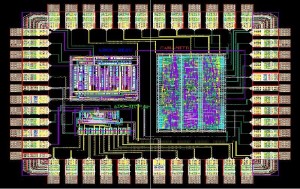In this blog post, Surbhi Agarwal, a student of UPES, Dehradun, who is currently pursuing a Diploma in Entrepreneurship Administration and Business Laws from NUJS, Kolkata, discusses the the major provisions contained in the SICLD Act, 2000.
The Semiconductor integrated circuit is an integral part of every computer chip. The main idea behind the Semiconductor Integrated Circuits Layout-Design Act (SICLD), 2000 is to provide protection of Intellectual Property Right (IPR) in the area of Semiconductor Integrated Circuit Layout-Designs and for matters connected therewith or incidental thereto. The Act fulfills the obligations of TRIPS agreement (Art.35 to 38) regarding the protection of semiconductor integrated circuits layout-designs. Therefore, the major provisions contained in the SICLD Act are as follows:
Definitions:
SICLD Act defines the following as:
- “Semiconductor Integrated Circuit” means a product having transistors and other circuitry elements, which are inseparably formed on a semiconductor material or an insulating material or of the semiconductor material and designed to perform an electronic circuitry function.[1]
- “Layout–Design” means a layout of the transistor and other circuitry elements and includes lead wires connecting such elements and expressed in any manner in a semiconductor integrated circuit.[2]
- “Commercial exploitation” in relation to the SLCLD means to sell, lease, offer or exhibit for sale or otherwise distribute such semiconductor integrated circuit for any commercial purpose.[3]
The Registration and Conditions of Registration:
- The Central Government will appoint a Registrar by notifying in the Gazette of India and will also appoint such other officials for fulfilling the functions prescribed under the Act. The officers will be abided by the stipulations of the Act under the guidance and instructions of the registrar.[4]
- The Act provides for the establishment of Semiconductor Integrated Circuits Layout- Design Registry, the main task of which is to assist registration of layout-designs.[5]
- A register will be kept at the head office of the Registry in which the details of the proprietor of the registered design will be included as specified under the Act. The register will be maintained under the direction and administration of the Registrar. [6]
- The Act prohibits the registration of certain layout designs which is not original, has been commercially exploited anywhere in India or in a convention country, which is not inherently distinctive and not differentiable from other designs registered. Where the design has been created by the intellectual labors of the inventor and is distinctive, such designs will be considered original under the Act.[7]
Procedure for and duration of registration:
- For the purpose of registering the layout design in the manner specified under the Act, the inventor of the design shall file an application in writing in the registry where the business is carried on[8] and when the application is acknowledged, such acceptance shall within 14 days is to be published in the specified terms.[9]
- Any person may, within three months from the date of the advertisement give notice in writing in a prescribed manner to the Registrar of opposition to the registration.[10]
- The layout design has been legally protected under the Act for a term of ten years starting from the date of submitting the application or on the date when the design was first utilized for commercial purposes; either is in advance.[11]
Effect of Registration:
- The Act specifically provides that an action for breach is not allowed for an unregistered design.[12]
- The registered owner of the design will acquire exclusive right to utilize the layout design and to acquire relief in case of a breach in the mode specified by the Act.[13]
Assignment and Transmission:
- The Act confers power on the registered owner to consign the right on the layout design and to furnish a receipt for every consideration for such transfer.
- A registered layout-design shall be assignable and transmissible whether with or without the goodwill of the business concerned.[14]
Appellate Board:
- The Act empowers the Central Government to constitute a Layout design Appellate Board to implement the jurisdiction, influence, and right as specified under the legislation.[15]
- The Appellate Tribunal will entertain appeals against the orders made by the Registrar within three months from the date of order.[16]
- The tribunal will be guided by the principles of natural justice and not bound to follow the procedure laid down under the Civil Procedure Code.[17]
- An aggrieved person by order of the Tribunal will appeal before the concerned High Court as per the procedure stipulated under the Act.[18]
Offenses, Penalties, and Procedure:
The Act also provides for a penalty in case of breach of layout designs. The person will be punishable with imprisonment for a term which may extend to three years, or with fine which shall not be less than fifty thousand rupees but which may extend to ten lakh rupees or with both.[19]
Miscellaneous:
The Act confers power on the Central Government to formulate rules to execute the provisions of the legislation. This Act is a novel legislation to grant protection for the scientific and technological inventions and to prevent the exploitation of such works by an unauthorized user.
Any countries accord to the citizens of India similar privileges and rights as granted to its citizens; the Central Government may specify such country to be a convention country and provide the citizens of such convention countries the similar privileges as granted to citizens to India under the Act.[20]
Conclusion:
The intellectual property protection for Integrated Circuit Layout design is a key factor throughout the world, and more so in India, because it does not have a strong intellectual property protection policy in software. As integrated circuit layout designs are in its early years in India, it is important that the country boasts of a strong protection policy right in the beginning itself and SICLD Act provides such a strong protection policy.
The number of Indian companies focusing on integrated circuit design is beginning to grow, and this would force major semiconductor companies to set up their offices and address the needs of the domestic market. This will encourage a lot more companies to base their operations in India.
The Indian legislation, therefore, provides a comprehensive protection to the layout designs of semiconductor integrated circuits as recognized intellectual property and bundle of rights to the proprietor of the registered layout-design.
Footnotes:
[1] Section 2(r) of the Act.
[2] Section 2(h) of the Act.
[3] Section 2(e) of the Act.
[4] Sec 3 of the Act.
[5] Section 4 of the Act
[6] Section 5 and 6 of the Act
[7] Sec 7
[8] Sec 8
[9] Sec 10
[10] Sec 11.
[11] Sec 15.
[12] Sec 16
[13] Sec 17
[14] Sec 20
[15] Sec 32
[16] Sec 42
[17] Sec 43
[18] Sec 53
[19] Sec 56
[20] Sec 93
 Serato DJ Crack 2025Serato DJ PRO Crack
Serato DJ Crack 2025Serato DJ PRO Crack














 Allow notifications
Allow notifications



